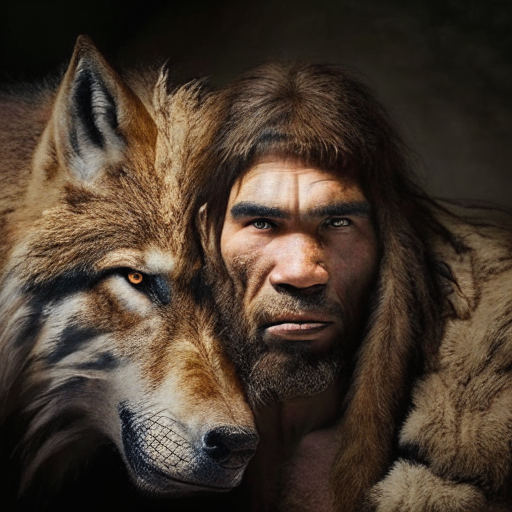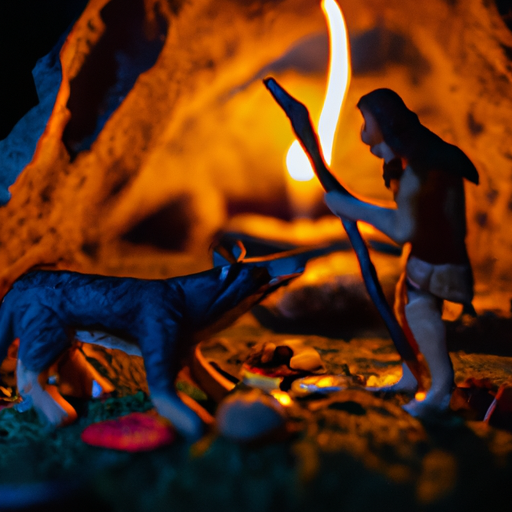A synonym of taming is domestication, which is the adaption of an animal from its wild state to life in close association with humans.
Dogs were the first domesticated species and started to live side by side with humans in the twilight of last the Pleistocene ice age. About 11.700 years ago a remarkable chapter in human history unfolded—an intricate tale of survival, companionship, and an extraordinary bond that transcended species. As the glaciers receded and a warmer world emerged, our ancestors found solace and assistance in the early domesticated dogs who played a crucial role in shaping human civilization.
With the ice age ending, the environment transformed, opening up vast landscapes and providing humans with opportunities for exploration, expansion, and an entirely new way of living: Humans transitioned from being nomadic hunter-gatherers to settling in agricultural communities
Amidst this backdrop of change, the remarkable domestication of dogs occurred. The exact timeline and process of dog domestication remain subjects of ongoing scientific investigation, but the general consensus is that the process likely began during the late Paleolithic or early Mesolithic era, around 15,000 to 20,000 years ago when unambiguously domesticated dogs are common in the archaeological records as canine skulls with shorter faces and wider eye sockets were found. Early signs of domestication even date back to 33,000 years ago when an ancient, doglike skull was uncovered in the Siberian Mountains.
Ancient humans found dogs to be so important for their lives that they wanted to stay close to them even in death, so they started to bury their new best friends alongside them.14,000 years ago an approximately 6-month-old domesticated, sick puppy was buried at a site in Bonn-Oberkassel, Germany in a grave together with a middle-aged man, twenty-something woman and grave goods including a bone hairpin, elk sculpture and the penis bone of a bear.
Domestication wasn’t a one-way street and happened slowly over many generations and cannot be simplified by portraying the scenic story of one of our ancestors having a soft spot for cuteness and picking up a wolf puppy, adopting and taming it.

The early domesticated dogs proved to be invaluable to our human ancestors as their exceptional olfactory senses and acute hearing made them exceptional hunting companions. Dogs assisted in tracking and locating game, increasing the efficiency of hunting expeditions. The co-evolution and partnership between humans and dogs led to successful hunts, securing a stable food source for early communities. Beyond hunting, dogs offered protection and security to their human companions as alone the presence of dogs acted as a deterrent to potential predators and intruders.
But it was not only hunting and protection that early man chose to live together with dogs. Almost instantly a profound emotional bond developed between humans and their canine companions. Same as today, dogs provided companionship and emotional support, while easing the challenges of the rapidly changing world and forging the foundations of future human-dog partnerships, with dogs becoming man’s best friend. Soon humans trained dogs to carry supplies, pull sleds and provide warmth during cold nights.
There are several theories of how this domestication occurred and no definite answer can be found about how out of fearful yet aggressive wolves, who competed with humans for food sources, our trusting and loyal dogs emerged. One theory focuses that it was not the survival of the fittest but rather the „survival of the friendliest“ and suggests that over generations wolves largely domesticated themselves around the campfires of hunter-gatherer people. While scavenging through the remains of their kills and the meat leftovers of early humans, who were not yet fully adapted to a carnivorous diet, as they simply could not digest protein very well, wolves that acted aggressively and boldly were likely to be killed by humans, but the more friendly ones were tolerated and maybe even fed protein-rich meat.
The physical changes that appeared in dogs in just a few generations, including splotchy coats, curly tails, and floppy ears even lead to dogs developing new facial musculature, notably a muscle responsible for furrowing the brow which resulted in so-called „puppy dog eyes“. When humans and dogs gaze lovingly into one another’s eyes, each of their brains secretes oxytocin, a hormone linked to maternal bonding and trust. Many if not most of us have strong reactions when we look at a dog’s face. Pups seem to know that we respond to their expressions, too — they make more of them when we’re paying attention than when we’re not. As it turns out, it’s mutual and the ability to communicate with and read facial cues is highly enhanced in domestic dogs as compared to their wild ancestors. Even our closest relatives—chimpanzees and bonobos—can’t read our gestures as readily as dogs can. Dogs are remarkably similar to human infants in the way they pay attention to us.
All this follows a pattern of a process known as self-domestication. We did not domesticate dogs. Dogs domesticated themselves!

One recent study shows how by bonding with us and learning to work together with humans, dogs may have actually become worse at working together as a species. Their pack lifestyle and mentality appear to be reduced and are far less prevalent even in wild dogs than it is in wolves. But dogs may have compensated in other interesting ways: They’ve learned to use humans to solve problems. Many domesticated dogs are also skilled at using “gaze alternation” to direct their human companions’ attention toward problems that they are unable to solve, such as extracting a hidden treat from a container, or their attempt to „beg for help“.
In addition, although it may not be a pleasant notion, dogs might have served as an emergency food source during challenging times. In an era devoid of refrigeration and lacking the means to store crops, hunter-gatherer societies had limited food reserves until the domestication of dogs. In times of scarcity, dogs that were less effective hunters could have been sacrificed to sustain the group or to preserve the best hunting dogs. As humans recognized the value of keeping dogs as a contingency food supply, it was not a significant leap to realize that plants could be utilized in a similar manner.
For ages, dogs worked alongside man performing the most incredible tasks in supporting humans. Hunting is one of the oldest jobs that dogs have performed alongside humans. Cave art dating back to the Neolithic age depicting dogs and humans hunting together has been found.
Another important work for dogs was pulling sleds, which dates back to at least 6000 BC. Remnants of sleds and harnesses have been found with canine remains in Siberia which carbon-dated to 7800–8000 years ago. A dog musher will need to develop a close bond sometimes with as many as 20 or more dogs in their kennel in order to keep a highly responsive and loyal team. The musher will need to cultivate a particularly strong relationship with their lead dog. The lead dog will ultimately decide which path the team takes.
Throughout history, dogs have played an integral role in human warfare. From ancient civilizations to modern conflicts, dogs have been employed as valuable assets in battle, showcasing their remarkable skills, loyalty, and adaptability. In the annals of ancient wars, dogs fulfilled diverse roles. They were employed as sentries, scouts, trackers, and even combatants. Their acute senses, agility, and unwavering loyalty made them formidable assets on the battlefield.
The utilization of dogs in warfare can be traced back to the ancient civilizations of Egypt, Assyria, and Greece. Egyptian artwork and inscriptions depict war canines employed as sentries, scouts, and even in combat. The Assyrians and Greeks also recognized the military value of dogs, incorporating them into their armies for similar roles.
The Roman Empire took the use of war dogs to a new level. Employing large and ferocious Molossian and Mastiff breeds, known as “Canes Pugnaces,” the Romans used them to instill fear, guard encampments, and even participate in attacks. These well-trained and highly disciplined dogs became an integral part of the Roman military machine.
The US military extensively utilizes dogs in various roles, recognizing their exceptional abilities and unwavering loyalty. These highly trained canines serve in specialized units such as the Military Working Dog (MWD) teams, which include both explosive detection dogs (EDDs) and patrol dogs. EDDs are vital in detecting and neutralizing explosive devices and protecting military personnel and civilians from potential threats. These dogs undergo intensive training to detect a wide range of explosives and provide critical support in counterterrorism and combat operations. Patrol dogs, on the other hand, are employed for security purposes, guarding military installations, conducting patrols, and apprehending individuals deemed a potential danger. They possess advanced tracking and apprehension skills, enabling them to apprehend suspects swiftly and effectively. Additionally, search and rescue dogs are employed to locate missing or injured individuals in disaster-stricken areas or combat zones. Their keen sense of smell and agility enable them to navigate through challenging terrain, saving lives in critical situations.
The relationship between a soldier and his dog is often cited as deeply rooted and unshakable, with the result being that the handler and the dog can read almost imperceptible changes in each other’s body language. In the US military, the military working dog is traditionally one rank higher than his handler so that he is afforded the respect they deserve.
Nowadays dogs are used for highly skilled tasks and work aiding humans and saving lives. One example is search dogs. Because of their highly developed sense of smell many canines today work with their handlers to search for many things including drugs, invasive species, and people trapped under snow or rubble after natural disasters. The first search and rescue dogs were the St. Bernard’s who were trained to locate lost or stranded travelers in the Swiss Alps.
There is a huge variety of assistant dogs, who support humans who face challenges in their lives. Not only as guide dogs for visually impaired people, but also as companions and help for people who suffer from isolation, depression, and other mental illness to the point where it significantly interferes with day-to-day life and may find security in an emotional support animal. Therapy dogs are used in hospitals around the world where they can have a positive impact on a variety of diagnoses, including cancer.
In modern times, the primary role of dogs has transitioned to being cherished companions and beloved members of our households. Many no longer have specific tasks or responsibilities beyond being by our side, offering unwavering companionship and friendship.
According to the American Pet Products Association (APPA) National Pet Owners Survey 2021-2022, approximately 63.4 million households in the United States, or roughly 53% of households, own a dog.
In the realm of self-psychology, animals can serve as “self-objects,” providing a sense of unity, support, and nourishment to an individual’s self-identity. This psychological perspective sheds light on the profound significance of certain animals in shaping a person’s well-being. Dogs, in particular, play a crucial role in people’s lives, helping them establish a structured daily routine and offering something to anticipate each day. Research further demonstrates that owning a dog can effectively diminish stress, alleviate anxiety, and potentially contribute to a longer lifespan.